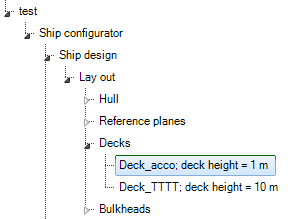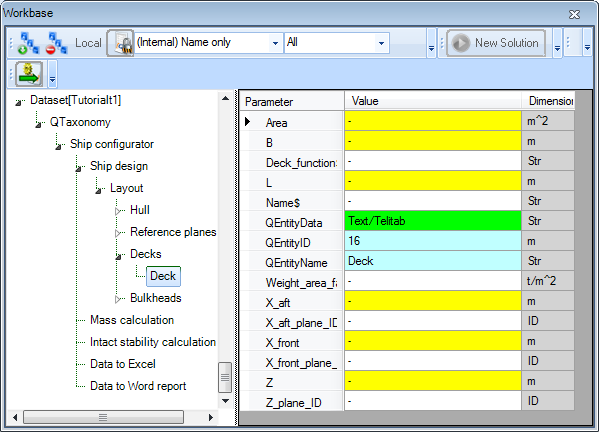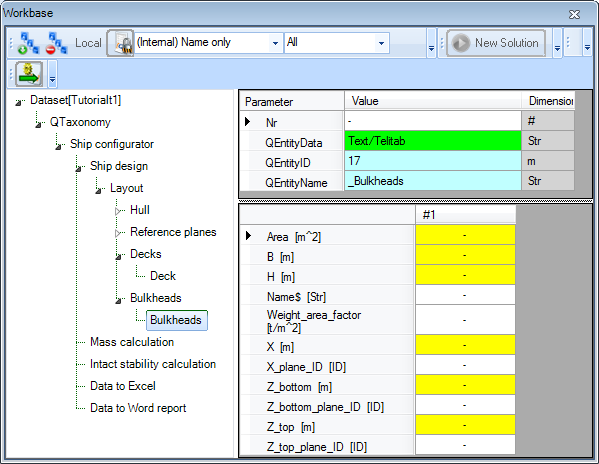Page History
...
As a child of entity Decks you have already included included the multiple (select one of more) entity Deck (see Developing a ship design process).
Thw The entity Decks can contain one or more Deck entities, each containing the same parameters and relations. However, the user can provide different input values for every Deck.
During the computation, the user will be asked the number of Deck entities he/she wants to include. If you include the Nr parameter in the "container” entity “ Decks, this will be the parameter which determines the number of Deck entities that will be placed, because Nr contains an @NRINST attribute in the Data, as explained in Some handy attributes.
- Add a new class under
Top Goals/Undefined:Excel.
The class Excel is a container for everything that will be calculated by Excel later on.
- Add the following parameters in the Knowledge Browser:
Parameter name | Dimension | Determined by | Reference | In Class |
| [m^2] | USR: User or system/equation | Total deck area | Excel |
| [Telitab] | USL: User or system/function | Table of deck data | ExcelDimensions |
| [m^2] | USR: User or system/equation | Total accommodation deck area | Dimensions |
| [Telitab] | USL: User or system/function | Table of all accommodation deck data | Dimensions |
...
- Include the following parameters in entity
Decks:Nr,Total_deck_area,Deck_data#,Total_accommodation_area,Total_accommodation_area#,QEntityRef.
| Info | ||
|---|---|---|
| ||
If you forgot in which class you put a parameter, use the seach box at the top of the Knowledge Browser to find it for you. |
...
- Include the following parameters in entity
Deck:Name$,Area,B,Deck_function$,L,Weight_area_factor,X_aft,X_aft_plane_ID,X_front,X_front_plane_ID,Z, andZ_plane_ID. - Add the following relations (an explanation will follow):
...
B = ENTITY#(
...
12).Boa (
...
12 is the value of QEntityId of entity MainDimensions)
Area = L*B
L = X_front - X_aft
- Set the attribute @SHOW on
QEntityData
All parameters in entity Deck should be in list view and not in table view, because all values are single values. So, parameters Z and Name$ in entity Deck are automatically placed in the table view because you have set a @MULTVAL attribute on these parameters earlier.
...
- Localize ("instantiate") the parameter
Weight_factor_area - Set the @HIDE attribute on it.
We will come back to this last parameter in Mass calculation.
How to connect the start and end position to the reference planes will be discussed next.
...
Now, you will create a selection list from available data to position a deck according with respect to specified reference planes.
...
- Add the following attributes to parameter
X_aft_plane_ID: - @SELECTENTITY
:14(QEntityID ofTransverse planes).The entityTransverse planesis used to create a selection list from with the other attributes. - @SELECTENTITYKEY:
CaseID. The parameterCaseIDis the parameter (of entityTransverse planes) whose values must be listed for selection. - @SELECTENTITYKEYTEXTPAR:
Name$. The parameterName$defines the case description that must be displayed in the selection list. - @EQEXPLAIN. This results in the display of description rather than value, e.g. in a combobox.
...
Note that you may have a different value than 14 here, because it depends on the sequence of creating Entities entities in a Taxonomy Entity the tree!
By including the attributes as described above, the user can select a reference plane from a drop down list, containing the names of all defined transverse reference planes. The result of the selection is a value of parameter CaseID, but the value of parameter Name$ is shown to the user instead.
...
- Add the following relation:
X_aft = ENTITY#(14).X.X_aft_plane_ID
This means the following: entity Transverse planes (in this example 14) contains a table of transverse planes, in which each column (case) represents a transverse plane. When the user has selected the second name from the table, the value of X_aft_ID will be 2 (although Name$ was presented to the user). So, the value of X_aft will become the second “X” value from the table within entity Transverse planes (X_aft = ENTITY#(14).X.2)
- Include exactly the same attributes for parameter
X_front_plane_IDas you did forX_aft_plane_IID. - Add the following relation:
X_front = ENTITY#(14).X.X_front_plane_ID
- Do the same for
“ZZ_plane_ID.Here, you have to refer to theQEntityIDof entityHorizontal planes, in our example “ 15”. - Create the following relation:
Z = ENTITY#(15).Z.Z_plane_ID
...
4 Provide a name for a multiple entity
As shown in Figure 21the calculation result above, each Entity Deck entity node name of a Deck contains the name and height of a deck. This can be developed accomplished by using the attribute @OBJECTTITLE in parameter “QEntityData” of Entity “entity Deck”. Behind this value you You can provide a flexible string, for example.:
@OBJECTTITLE:"Deck_" + Name$ + "; deck height = " + STR$(Z) + " m"
In here Here, everything place between quotes will be presented as text. The value of a string parameter like “Name$” will also be shown as text. Finally And, if you also want to present a the value of a parameter ( which is not a string by itself) within the node name of an Entity of the string type, you first have to make convert it to a string of it, for example STR$(Z). See help function of Quaestor or STR$().To add
- Add the @OBJECTTITLE attribute to
QEntityData. For this, double click on the parameter value. The content will open in a
...
- larger editor
...
- window.
5 Combine data from child entities
You now will
2.3.9.3 End result Entity “Deck”
The end result of Entity “Deck” is presented in Figure 77.
Figure 77: Entity "Deck"
Please note that you can always change the presentation sequence of parameters by using a @ORDER attribute, see section 2.3.2.4 of this part. You can include presentation names for parameters which differ from the parameter name itself as explained in section 2.3.6.7. In Figure 77 this is done for parameter “Name$”.
2.3.10 Create relations in Entity “Decks” which combines data from child Entities below
We want to create a table with a subset of parameter values of all defined decks.
The QEntity() expression collects expression collects parameters of all child entities.
- Create the following relation in
...
- entity
Decks
...
- :
Deck_data# = QEntity(@Name$, @Deck_function$, @Z, @X_aft, @X_front, @Area)
We want to present the The total accommodation area will be shown separately. ThereforeFor this, parameter “Total_accommodation_area#” is introduced that should be a table (Telitab) that only contains data of decks with a "Deck_function$" = "Accommodation". We use the QUERY# , which is a Telitab (as its name ends with #). It should only contain data of decks for which Deck_function$ returns Accommodation. Use the QUERY# function, which returns a Telitab subset on the basis of a set of search criteria.
- Create the following relation in entity
Decks:
Total_accommodation_area# = QUERY#(Deck_data#, "NullString",
...
"Accommodation":"Deck_function$")
Next sums of the datasets are will be made using the SUM SUM function.
- Create the following relations:
Total_deck_area = SUM(Deck_data#, 1, "Area")
Total_accommodation_area = INCASE(Total_accommodation_area# = "0" + Qcrlf, THEN, 0, ELSE, SUM(Total_accommodation_area#, 1, "Area"))
You see that the The second relation has a condition (the INCASE() function). If “Total_accommodation_area#” is an empty table (which is possible if the user do does not create decks with "Deck_function$" = "Accommodation") then the total accommodation deck area is 0 [m2]. Because the content of an empty table in Quaestor will be: "0" + Qcrlf (in which Qcrlf is a Carriage return-line feed string constant) this should be the value to test the parameter onagainst.
Please note see in the rest of the wiki for more detailed information about functions used above.
- Add the “QEntityRef” and “QEntityData” parameters to “Decks”;
QEntityRefparameter toDecks - Assign the following text for “QEntityRef”; value “
Combined data of all decks” as explanation to the user. - To show computed values during a dialogue write “@SHOW” behind “QEntityData”.
2.3.11 Entity “Bulkheads”
- to
QEntityRef - Set the @SHOW attribute on
QEntityData
6 Entity Bulkheads
As mentioned in Developing a ship design processAs mentioned in the first part, this ship configurator uses a different Entity entity structure for defining (transverse) bulkheads in comparison with defining decks. Of course the same Entity entity structure could be used, but it is more instructive to present (and develop) a different approach.
The development of the Bulkhead Entity Bulkheads entity is comparable to the Decks Entity entity. However, in the previous paragraphs we used a multiple Entity entity was used to enable the user to define one or more decks. Now we will develop an Entity Here an entity is developed where the user can create one table to define one or more transverse bulkheads instead of several Deck entities. Create another child Entity “Bulkheads” below the existing Entity “Bulkheads”.
| Bulkheads | child of “Bulkheads” | Entity type: singular obligatory |
Contrary to Deck (child of Decks), which is multiple, the child entity Bulkheads (child of Bulkheads) is singular.
- Create the following parameters in the Knowledge Browser.:
Parameter name | Dimension | Determined by | Reference | In Class |
| [m] | USR: User or system/equation | Height | Dimensions |
| [ID] | VR: User only | Define X position of bulkhead by selecting a transverse reference plane | Dimensions |
| [m] | VR: User only | Bottom position bulkhead in Z (vertical) direction | Dimensions |
| [m] | VR: User only | Top position bulkhead in Z (vertical) direction | Dimensions |
| [ID] | VR: User only | Define bottom Z (vertical) position of bulkhead by selecting a horizontal reference plane | Dimensions |
| [ID] | VR: User only | Define top Z (vertical) position of bulkhead by selecting a horizontal reference plane | Dimensions |
- Include the following parameters in last child entity
Bulkheads: Nr,Name$,Area,B,H, Next include the following parameters in last created Entity “Bulkheads“: “Nr”, “Name$”, “Area”, “B”, “H”, “Weight_area_factor”, “X”, “X_plane_ID”, “Z_bottom”, “Z_bottom_plane_ID”, “Z_top”, “andZ_top_plane_IDand “QEntityData”.
Take care that with With exception of parameter “Nr” and “QEntityData” and the QEntity* parameters all parameters are must be placed within the table view (if not, instantiate view.
- Localize ("instantiate") the relevant parameters and
...
- set the attributes @MULTVAL.
- To show computed values during a dialogue write “@SHOW” behind “QEntityData”
- Set attribute @SHOW on
QEntityData
Again, Again we want to create a selection list must be created from data in the reference Entities entities to position , in this case, position a bulkhead. In section 2.3.9.1 of this part we section 3 it was explained how to achieve this for decks.
- Use this method for the new parameters
...
X_plane_ID
...
- ,
...
Z_bottom_plane_ID
...
- , and
...
Z_top_plane_ID
...
- .
- Next create the following relations:
Area = B*H
B = ENTITY#(
...
12).Boa (
...
12 is the value of QEntityId of
...
entity MainDimensions)
H = Z_top - Z_bottom
X = ENTITY#(
...
14).X.X_plane_ID (
...
14 is the value of QEntityId of
...
entity Transverse planes
...
)
Z_bottom = ENTITY#(
...
15).Z.Z_bottom_plane_ID (
...
15 is the value of QEntityId of
...
entity Horizontal planes
...
)
...
Z_
...
top = ENTITY#(
...
15).Z.Z_top_plane_ID (
...
15 is the value of QEntityId of
...
entity Horizontal planes
...
)
...
As for the parameter in Deck, the parameter “Weight_factor_area” show be instantiated and be provided with the @HIDE attribute. We will come back to this parameter in section 2.4.1.3 of this part.
The end result of Entity “Bulkheads” is presented in Figure 78.
Figure 78: Entity "Bulkheads"
...
- | << Previous | Next >>






